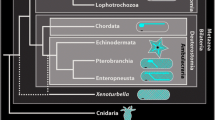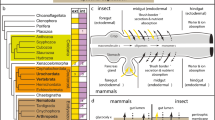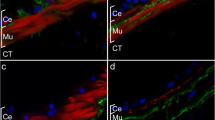Abstract
Enteroendocrine cells are endocrine-like cells found in the luminal epithelia of the digestive tract. These cells have been described in most animal phyla. In echinoderms, the cells have been described mainly in organisms of the class Asteroidea (sea stars) and Holothuroidea (sea cucumbers). Here, we describe what is known about the enteroendocrine cells of the Echinodermata, including the cell types, their distribution in the digestive tract, their neuropeptide content and their regeneration and compare them to what has been found in other animal species, mainly in vertebrates. We also discuss the newly described view of enteroendocrine cells as chemical sensors of the intestinal lumen and provide some histological evidence that similar functions might be found within the echinoderms. Finally, we describe the temporal regeneration of the enteroendocrine cells in the holothurian intestine.







Similar content being viewed by others
References
Bohórquez DV, Chandra R, Samsa L, Vigna S, Liddle R (2011) Characterization of basal pseudopod-like processes in ileal and colonic PYY cells. J Mol Histol 42:3–13
Bohórquez DV, Shahid RA, Erdmann A, Kreger AM, Wang Y, Calakos N, Wang F, Liddle RA (2015) Neuroepithelial circuit formed by innervation of sensory enteroendocrine cells. J Clin Invest 125(2):782–786
Bordi C, D’Adda T, Axxoni C, Ferraro G (2000) Classification of gastric endocrine cells at the light and electron microscopical levels. Microsc Res Tech 48(5):258–271
Burke RD, Angerer LM, Elphick MR, Humphrey GW, Yaguchi S, Kiyama T, Liang S, Mu X, Agca C, Klein WH, Brandhorst BP, Rowe M, Wilson K, Churcher AM, Taylor JS, Chen N, Murray G, Wang D, Mellot D, Olinski R, Hallböök F, Thorndyke MC (2006) A genomic view of the sea urchin nervous system. Dev Biol 300(1):434–460
Cai W, Kim CH, Go HJ, Egertova M, Zampronio CG, Jones AM, Park NG, Elphick MR (2018) Biochemical, anatomical, and pharmacological characterization of calcitonin-type neuropeptides in starfish: discovery of an ancient role as muscle relaxants. Front Neurosci 12:382
Díaz-Balzac CA, Vázquez-Figueroa LD, García-Arrarás JE (2014) Novel markers identify nervous system components of the holothurian nervous system. Invertebr Neurosci 14(2):113–125
Díaz-Balzac CA, Lázaro-Peña MI, Vázquez-Figueroa LD, Díaz-Balzac RJ, García-Arrarás JE (2016) Holothurian nervous system diversity revealed by neuroanatomical of the sea urchin genome analysis. PLoS One 11(3):e0151129
Díaz-Miranda L, Blanco RE, García-Arrarás JE (1995) Localization of the heptapeptide GFSKLYFamide in the sea cucumber Holothuria glaberrima (Echinodermata): a light and electron microscopy study. J Comp Neurol 352:626–640
Diwakarla S, Fothegill LJ, Fakhry J, Callaghan J, Furness JB (2017) Heterogeneity of enterochromaffin cells within the gastrointestinal tract. Neurogastroenterol Motil 29(6). https://doi.org/10.1111/nmo.13101
Elphick MR, Price DA, Lee TD, Thorndyke MC (1991) The SALMFamides: a new family of neuropeptides isolated from and echinoderm. Proc R Soc Lond 243:121–127
Fawcett DW (1994) Bloom and Fawcett, a textbook of histology. Chapman& Hall, NY
Fothergill LJ, Furness JB (2018) Diversity of enteroendocrine cells investigated at cellular and subcellular levels: the need for a new classification. Histochem Cell Biol 150:693–702
Furness JB (2006) The enteric nervous system. Blackwell Publishing, Massachusetts
García-Arrarás JE, Díaz-Miranda L, Torres II, File S, Jiménez LB, Rivera-Bermudez K, Arroyo EJ, Cruz W (1999) Regeneration of the enteric nervous system in the sea cucumber Holothuria glaberrima. J Comp Neurol 406:461–475
García-Arrarás JE, Rojas-Soto M, Jiménez LB, Díaz-Miranda L (2001) The enteric nervous system of echinoderms: unexpected complexity revealed by neurochemical analysis. J Exp Biol 204:865–873
Gershon MD (2013) 5-Hydroxytryptamine (serotonin) in the gastrointestinal tract. Curr Opin Endocrinol Diabetes Obes 20(1):14–21
Haber AL, Biton M, Rogel N, Herbst RH, Shekhar K, Smillie C, Burgin G, Delorey TM, Howitt MR, Katz Y, Tirosh I, Beyaz S, Dionne D, Zhang M, Raychowdhury R, Garrett WS, Rozenblatt-Rosen O, Shin HN, Yilmaz O, Xavier RJ, Regev A (2017) A single-cell survey of the small intestinal epithelium. Nature 551:333–339
Hinman VF, Burke RD (2018) Embryonic neurogenesis in echinoderms. Wiley Interdiscip Rev Dev Biol 7(4):e316
Inoue M, Birenheide R, Koisumi O, Kobayakawa Y, Muneoka Y, Motokawa T (1999) Localization of the neuropeptide NGIWYamide in the holothurian nervous system and its effects on muscular contraction. Proc R Soc B Biol Sci 266:993–1000
Kaelberer MM, Bohórquez DV (2018) The now and then of gut-brain signaling. Brain Res 1693:192–196
Kaelberer MM, Buchanan KL, Klein ME, Barth BB, Montoya MM, Shen X, Bohórquez DV (2018) A gut-brain neural circuit for nutrient sensory transduction. Science 361(6408):eaat5236
Kim CH, Go HJ, Oh Y, Jo YH, Elphick MR, Park NG (2018) Transcriptomics reveals tissue/organ-specific differences in gene expression in the starfish Patiria pectinifera. Mar Gen 37:92–96
Latorre R, Sternini C, De Giorgio R, Greenwood-Van Meerveld B (2016) Enteroendocrine cells: a review of their role in brain-gut communication. Neurogastroenterol Motil 28(5):620–630
Liddle RA (2019) Neuropods. Cell Mol Gastrol Hepatol In press. https://doi.org/10.1016/j.jcmgh.2019.01.006
Lin M, Egertová M, Zampronio CG, Jones AM, Elphick MR (2017) Pedal peptide/orcokinin-type neuropeptide signaling in a deuterostome: the anatomy and pharmacology of starfish myorelaxant peptide in Asterias rubens. J Comp Neurol 525(18):3890–3917
Lin M, Egertová M, Zampronio CG, Jones AM, Elphick MR (2018) Functional characterization of a second pedal peptide/orcokinin-type neuropeptide signaling system in the starfish Asterias rubens. J Comp Neurol 526:858–876
Martínez A, Villaro AC, Sesma P (1989) Microscopic study of the pyloric caeca of the starfish Marthasterias glacialis (Echinodermata): finding of endocrine cells. J Morphol 202:151–164
Martínez A, López J, Montuenga LM, Sesma P (1993) Regulatory peptides in the gut endocrine cells and nerves in the starfish Marthasterias glacialis. Cell Tissue Res 271:375–380
Martínez A, Riveros-Moreno V, Polak JM, Moncada S, Sesma P (1994) Nitric oxide (NO) synthase immunoreactivity in the starfish Marthasterias glacialis. Cell Tissue Res 275:599–603
Martínez A, Unsworth EJ, Cuttitta F (1996) Adrenomedullin-like immunoreactivity in the nervous system of the starfish Marthasterias glacialis. Cell Tissue Res 283:169–172
Mashanov VS, Zueva OR, Heinzeller T, Aschauer B, Dolmatov IY (2007) Developmental origin of the adult nervous system in a holothurian: an attempt to unravel the enigma of neurogenesis in echinoderms. Evol Dev 9(3):244–256
Moore SJ, Thorndyke MC (1993) Immunocytochemical mapping of the novel echinoderm neuropeptide SALMFamide 1 (S1) in the starfish Asterias rubens. Cell Tissue Res 274:605–618
Newman SJ, Elphick MR, Thorndyke MC (1995) Tissue distribution of the SALMFamide neuropeptides S1 and S2 in the starfish Asterias rubens using novel monoclonal and polyclonal antibodies. I. Nervous and locomotory systems. Proc R Soc Lond B 261:139–143
Rowe ML, Elphick MR (2012) The neuropeptide transcriptome of a model echinoderm, the sea urchin Strongylocentrotus purpuratus. Gen Comp Endocrinol 179:331–344
Rowe ML, Achhala S, Elphick MR (2014) Neuropeptides and polypeptide hormones in echinoderms: new insights from analysis of the transcriptome fo the sea cucumber Apostichopus japonicus (2014). Gen Comp Endocrinol 197:43–55
Semmens DC, Mirabeau O, Moghul I, Pancholi MR, Wurm Y, Elphick MR (2016) Transcriptomic identification of starfish neuropeptide precursors yields new insights into neuropeptide evolution. Open Biol 6:150224
Sinagoga KL, McCauley HA, Múnera JO, Reynolds NA, Enriquez JR, Watson C, Yang HC, Helmrathe MA, Wells JM (2018) Deriving functional human enteroendocrine cells from pluripotent stem cells. Development 145(19):dev165795
Suwansa-ard S, Chaiyamoon A, Talarovicova A, Tinikul R, Tinikul Y, Poomtong T, Elphick MR, Cummins SF, Sobhon P (2018) Transcriptomic discovery and comparative analysis of neuropeptide precursors in sea cucumber (Holothuroidea). Peptides 99:231–240
Tian S, Egertová M, Elphick MR (2017) Functional characterization of paralogous gonadotropin-releasing hormone-type and corazonin-type neuropeptides in an echinoderm. Front Endocrinol 8:1–24
Tinoco AB, Semmens DC, Patching EC, Gunner EF, Egertová M, Elphick MR (2018) Characterization of NGFFYamide signaling in starfish reveals roles in regulation of feeding behavior and locomotory systems. Front Endocrinol 9:507
Tossas K, Qi-Huang S, Cuyar E, García-Arrarás JE (2014) Temporal and spatial analysis of enteric system regeneration in the sea cucumber Holothuria glaberrima. Regeneration 1(3):10–26
Yañez-Guerra LA, Delroisse J, Barreiro-Iglesias A, Slade SE, Scrivens JH, Elphick MR (2018) Discovery and functional characterisation of a luqin-type neuropeptide signaling system in a deuterostoms. Sci Rep 8:7220
Zandawala M, Moghul I, Yañez-Guerra LA, Delroisse J, Abulkassimova N, Hugall AF, O’Hara TD, Elphick MR (2017) Discovery of novel representatives of bilaterian neuropeptide families and reconstruction of neuropeptide precursor evolution in ophiuorid echinoderms. Open Biol 7:170129
Acknowledgments
We would like to thank Ms. Griselle Valentin for editorial help and the preparation of the figures.
Funding
This project was funded by NIH (Grant R15NS01686). We also acknowledge partial support from NIH R21AG057974 and the University of Puerto Rico.
Author information
Authors and Affiliations
Corresponding author
Ethics declarations
Conflict of interest
The authors declare that they have no conflict of interest.
Ethical approval
Most data have been previously published and are available in the scientific literature. In the case of unpublished data applicable, international, national and/or institutional guidelines for the care and use of animals were followed.
Additional information
Publisher’s note
Springer Nature remains neutral with regard to jurisdictional claims in published maps and institutional affiliations.
Rights and permissions
About this article
Cite this article
García-Arrarás, J.E., Lefebre-Rivera, M. & Qi-Huang, S. Enteroendocrine cells in the Echinodermata. Cell Tissue Res 377, 459–467 (2019). https://doi.org/10.1007/s00441-019-03053-3
Received:
Accepted:
Published:
Issue Date:
DOI: https://doi.org/10.1007/s00441-019-03053-3




